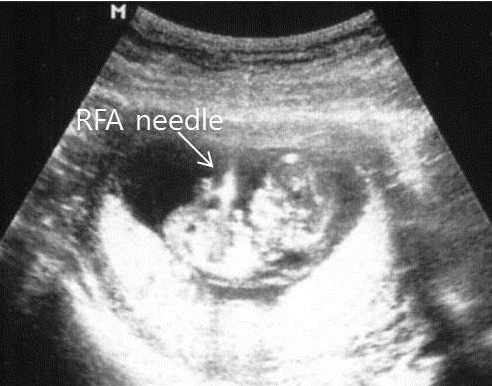Perinatology.
2018 Dec;29(4):180-184. 10.14734/PN.2018.29.4.180.
Monochorionic Triamniotic Triplet Pregnancy Following Assisted Reproductive Technology and Radiofrequency Ablation for Selective Reduction
- Affiliations
-
- 1Department of Obstetrics and Gynecology, Chonbuk National University Medical School, Jeonju, Korea. obgyn2001@jbnu.ac.kr
- 2Research Institute of Clinical Medicine of Chonbuk National University-Biomedical Research Institute of Chonbuk National University Hospital, Jeonju, Korea.
- KMID: 2430222
- DOI: http://doi.org/10.14734/PN.2018.29.4.180
Abstract
- In assisted reproductive techniques, monozygotic twinning is not influenced by the trial of reducing the number of embryos transferred. We present extremely rare case of monochorionic triamniotic triplet pregnancy following in vitro fertilization and two-embryo transfer. During the first trimester, the crucial ultrasound findings of monochorionic triamniotic triplet pregnancy are three distinct amniotic sacs forming a triangle or ipsilon zone within a single chorionic cavity. After prudential counseling about the potential risk of a monochorionic triamniotic triplet pregnancy with the patient, selective reduction of two fetuses via radiofrequency ablation was performed. We report a case of selective reduction for monochorionic triamniotic triplet pregnancy using radiofrequency ablation at 12 weeks' gestation and obstetric progression after radiofrequency ablation was uneventful until 20 weeks' gestation.
MeSH Terms
Figure
Reference
-
1. De Catte L, Camus M, Foulon W. Monochorionic high-order multiple pregnancies and multifetal pregnancy reduction. Obstet Gynecol. 2002; 100:561–566.
Article2. Imaizumi Y. A comparative study of zygotic twinning and triplet rates in eight countries, 1972–1999. J Biosoc Sci. 2003; 35:287–302.
Article3. Wenstrom KD, Syrop CH, Hammitt DG, Van Voorhis BJ. Increased risk of monochorionic twinning associated with assisted reproduction. Fertil Steril. 1993; 60:510–514.
Article4. Schachter M, Raziel A, Friedler S, Strassburger D, Bern O, Ron-El R. Monozygotic twinning after assisted reproductive techniques: a phenomenon independent of micromanipulation. Hum Reprod. 2001; 16:1264–1269.
Article5. Milki AA, Jun SH, Hinckley MD, Behr B, Giudice LC, Westphal LM. Incidence of monozygotic twinning with blastocyst transfer compared to cleavage-stage transfer. Fertil Steril. 2003; 79:503–506.
Article6. Ménézo YJ, Sakkas D. Monozygotic twinning: is it related to apoptosis in the embryo? Hum Reprod. 2002; 17:247–248.7. Iwamoto H, Yoshida A, Suzuki H, Tanaka M, Takeuchi T, Nakamura T, et al. Monochorionic triamniotic triplet pregnancies with assisted reproductive technology: two case reports. J Obstet Gynaecol Res. 2010; 36:872–875.
Article8. Tarlatzis BC, Qublan HS, Sanopoulou T, Zepiridis L, Grimbizis G, Bontis J. Increase in the monozygotic twinning rate after intracytoplasmic sperm injection and blastocyst stage embryo transfer. Fertil Steril. 2002; 77:196–198.
Article9. Cohen J. Assisted hatching of human embryos. J In Vitro Fert Embryo Transf. 1991; 8:179–190.
Article10. Radwan P, Radwan M, Kobielska L, Sikora J. Live birth of monochorionic triamniotic triplets after in vitro fertilization and blastocyst transfer: case report and review of the literature. Ginekol Pol. 2014; 85:154–157.
Article11. Kawaguchi H, Ishii K, Yamamoto R, Hayashi S, Mitsuda N. Perinatal Research Network Group in Japan. Perinatal death of triplet pregnancies by chorionicity. Am J Obstet Gynecol. 2013; 209:36.e1–36.e7.
Article12. Blumenfeld YJ, Shamshirsaz AA, Belfort MA, Hintz SR, Moaddab A, Ness A, et al. fetofetal transfusion syndrome in monochorionic-triamniotic triplets treated with fetoscopic laser ablation: report of two cases and a systematic review. AJP Rep. 2015; 5:e153–e160.
Article13. Sepulveda W, Sebire NJ, Odibo A, Psarra A, Nicolaides KH. Prenatal determination of chorionicity in triplet pregnancy by ultrasonographic examination of the ipsilon zone. Obstet Gynecol. 1996; 88:855–858.
Article14. Moise KJ Jr, Johnson A, Moise KY, Nickeleit V. Radiofrequency ablation for selective reduction in the complicated monochorionic gestation. Am J Obstet Gynecol. 2008; 198:198.e1–198.e5.
Article15. Paramasivam G, Wimalasundera R, Wiechec M, Zhang E, Saeed F, Kumar S. Radiofrequency ablation for selective reduction in complex monochorionic pregnancies. BJOG. 2010; 117:1294–1298.
Article
- Full Text Links
- Actions
-
Cited
- CITED
-
- Close
- Share
- Similar articles
-
- Prediction of Amnionicity Using the Number of Yolk Sacs in Monochorionic Multifetal Pregnancy
- Transvaginal Selective Fetal Reduction in Multifetal Pregnancy induced by Assisted Reproductive Technology
- Maternal and perinatal outcomes in triplet versus twin pregnancies with the result of Assisted Reproductive Technology
- Intrafetal Laser Treatment for Selective Feticide in Monochorionic Multiple Pregnancies
- A Case of Complete Hydatidiform Mole in a triplet pregnancy following In Vitro Fertilization and Embryo Transfer



